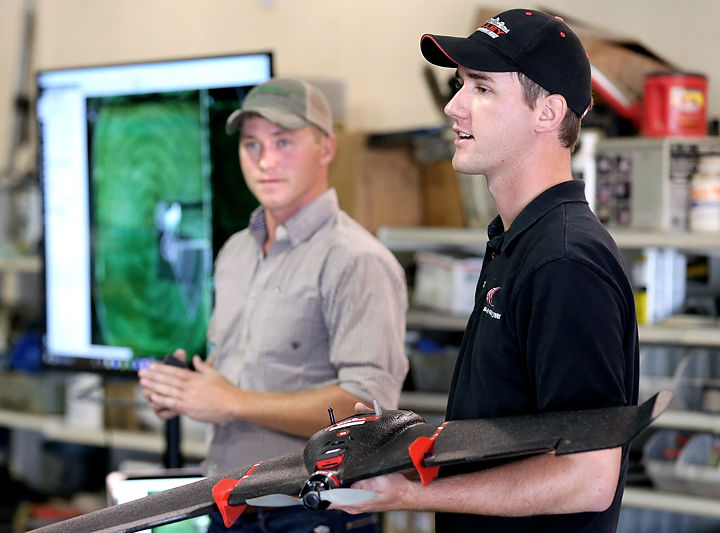
By Robert Pore, The Grand Island Independent
Area growers and ag students from the University of Nebraska-Lincoln got a briefing Wednesday about how growers can outfit and implement high-tech sensors into their farming operations.
The Project SENSE presentation was conducted at the farm of Ken Seim near Chapman.
Project SENSE (Sensors for Efficient Nitrogen Use and Stewardship of the Environment) is a pilot program in its third year that focuses on improving the efficiency of nitrogen fertilizer use.
During the first part of Wednesday’s presentation, UNL graduate students John Parrish and Joel Crowther talked with farmers about the accomplishments and challenges with the project. The students said that so far the strategies they are using to determine nitrogen in crops at early growth stages are showing promise in improving nitrogen fertilizer efficiency and lower groundwater nitrate levels.
Heavy rain that drenched the area Tuesday night prevented a demonstration of the project’s high-clearance nitrogen applicator outfitted with active crop canopy sensors that would have allowed the participants in the program to see high-tech sensors in action.
But Parrish and Crowther were able to share their eBee SQ fixed wing drone demonstration, which is new to the SENSE field day this year.
The demonstration included how to build a flight plan, calibrate the camera, launch the drone and post flight imagery analysis.
The drone is equipped with the same type of high-tech sensors used on the applicators. It is totally automated and its flight path can be planned shortly before application.
In the future, the students said, drone imagery will be used to help direct nitrogen recommendations during the growing season and will likely be targeted for fertigation through a pivot. But it could be turned into an application map and used in a sidedress machine. Another benefit from the imagery is detecting stressed areas in a field that can be targeted for scouting of the field.
Dean Krull is project demonstration coordinator for the Central Platte Natural Resources District and is also employed by UNL.
Krull said use of a drone in analyzing fields is new this year, making it possible to eventually incorporate drone technology into management decisions on the farm, especially in the area of nitrogen application.
“Drones have been around for a long time, but what we are doing here is taking the sensing devices we used on the high-clearance sprayers and putting one on a drone and have it fly the field and evaluate it,” he said.
With this being the first year of using drone technology, he said the project is in the “incubation” stage.
“We are trying to figure out how to use the technology, but I believe this has a lot of future use,” Krull said.
Crowther said sensors have become miniaturized enough to be fit on drones to “carry the payload necessary for agriculture.”
The sensors on the drone can photograph the near infrared spectrum, which gives the farmer additional information about the crop’s canopy structure and the health of the leaves and whether they are stressed.
“We can really define stress,” Crowther said. “The other things sensors have that your eyes wouldn’t is that they are able to quantify or put a number to that stress so we can manage it accordingly.”
That information can help farmers identify the area of the field where the crops need assistance, whether it’s water, chemicals for pest or disease problems or additional fertilizer to promote better growth. Those inputs are then applied to those specific areas of the field through a center pivot system instead of a general application of the field. That not only helps farmers save on the use of costly inputs, but is also better for the environment, especially when it comes to reducing nitrate levels in ground and surface water.
“We are typically applying a lot less of those inputs and we are applying them where they are needed,” Crowther said. “We can apply more where we can get that yield potential and back off on some of those inputs where they are not needed.”
This year they are contrasting the use of those sensors on applicators a few feet above the crop versus the use of sensors on drones a couple hundred feet off the ground.
“If we can figure out that they (drones) can do just as good of a job, then there are so many more applications for these drone sensors because of their timeliness and availability is a lot better than actually having to drive through a field,” Crowther said.
Project SENSE is a collaborative effort between UNL, the Nebraska Corn Board, five NRDs (Central Platte, Little Blue, Lower Loup, Lower Platte North, and Upper Big Blue) and producers participating in the Nebraska On-Farm Research Network.
For more information, contact the Central Platte NRD at (308) 385-6282 or e-mail: lee@cpnrd.org. Additional information is available at http://www.cpnrd.org. CCA credits are available.
More details at: http://www.theindependent.com/news/ag_news/area-farmers-students-learn-about-cutting-edge-ag-technology/article_31100372-82e2-11e7-b5f8-979e73d63f0b.html